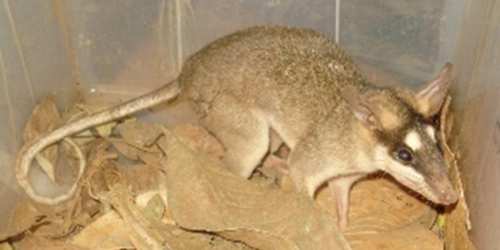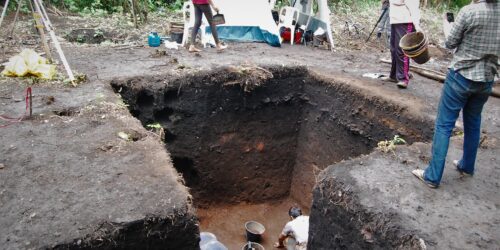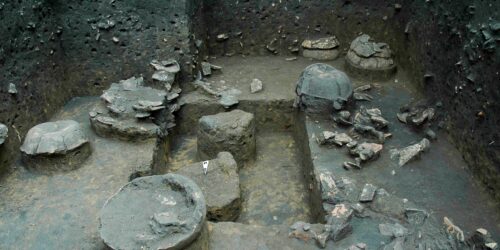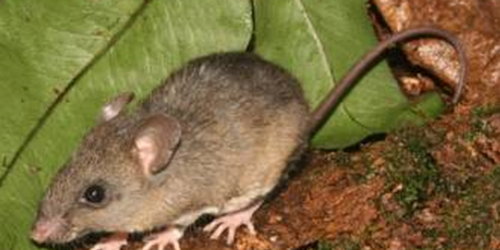Tupi or not Tupi: past and current migrations in South America
18th March 2021 | Duration of reading: 8 min
By Rafael Bisso-Machado
Continuing the research on Native American peoples, presented in our blog in the text Traces of the past: the history of Amazonian Native Americans revealed through genetics, here we will see how these peoples expanded and migrated in the Brazilian territory. We will present the results of a research that was published in the scientific journal American Journal of Physical Anthropology in 2013 (access here), which objective was to elucidate the expansion of Native American peoples who speak Tupi and Je through genetic, geographic and linguistics analyses.
Native American populations present in Brazil show a linguistic diversity that includes between 154 and 170 languages grouped in about 20 major linguistic trunks. The word “trunk” comes from the idea of a tree, which can contain countless branches that branch from a central trunk. Linguistic trunk is a set of language families that have the same origin. The Portuguese language, for example, belongs to the Indo-European trunk (Latin family). Portuguese looks a lot like Spanish and French, because they belong to the same linguistic trunk. In Brazilian territory there are two main native linguistic trunks: Tupi and Je.
The Tupi trunk is characterized by a large number of speakers who inhabit a wide geographical area in South America. Tupi-Guarani is its most comprehensive branch. The Guarani language currently has a wide geographical distribution, with speakers in Brazil, Argentina, Paraguay, Bolivia, Peru, Venezuela and French Guiana. It is worth mentioning that Guarani speakers reached the southernmost limits of the Tupi dispersion. Regarding the origin and expansion of Tupi, we know that a common center of Amazonian origin and Tupi differentiation occurred through distinct historical and cultural processes. The Tupi differentiation results from the emergence of several languages within the Tupi trunk from a common ancestral language, the so-called proto-Tupi. Linguistic information suggests that the Tupi origin occurred on the south bank of the Amazon River, close to the Madeira-Guaporé basin, while archaeological data points to a more northerly region, at the confluence of the Madeira and Amazon rivers. Morphological data also indicate an Amazonian origin for the Tupi group.
The expansion of Tupi speakers, which occurred about 6,000 to 2,000 years ago, is considered one of the largest and most successful migrations identified at the continental level. These people were known for making ceramic utensils and were described as skilled farmers. Tupi speakers efficiently transformed the forest into productive areas. Due to these characteristics, the best term for these population displacements would not be migration, but expansion, conquering new regions without abandoning the previous region. The reason for the Tupi people to leave the border with the Amazon, however, may have been for multiple reasons: demographic and/or socio-cultural pressures, the search for new arable land and/or prolonged droughts.
The origin of the Je linguistic trunk, on the contrary, is believed to have occurred in an area between the São Francisco and Tocantins rivers and may have originated at about the same time as the Tupi. Some researchers suggest that Tupi and Je would have separated from a common ancestral language about 7,000 to 5,000 years ago. Most of the Je-speaking communities are located in the central and eastern regions of the Brazilian plateau, and an important movement to the south occurred about 3,000 years ago. However, the dispersion of the Je seems to be different from the pattern followed by the Tupi.
But for some years now, genetics has joined these studies to seek greater details of these prehistoric migrations. Genetic data has then been used to show a broader view of how the spread of the Tupi and Je peoples in South America would have occurred.
These genetic-linguistic studies (as seen in Ramallo et al. 2013) determined that Tupi and Je expanded in different ways. While Tupi expanded following a radial pattern (dispersing equally in all directions from a center of origin), with isolation generated by distance (the genetic differentiation between individuals increases as geographic distances increase), Je has a more complex / irregular dispersion mode.
This correlation between genetic and linguistic evolution can be explained by the history of populations. Two populations that separate begin to show differences in both genes and languages over time. It is reasonable to assume that the greater the isolation and the more time that elapses since the separation between them, the greater the differences. For a better understanding of how to interpret genetic and linguistic trees, access this material from the Universo Racionalista..
These results reinforce that the use of genetic and linguistic data, together, allows to rescue how the prehistoric migrations of the Native American peoples occurred. This is all the more important with the imminent extinction of hundreds of Native American languages. In the next text, we will see how linguistic variability, together with geography, can influence the genetic variability of Native American populations.
Science is done collaboratively
The text presented is the result of research carried out by Rafael Bisso Machado in collaboration with researchers from Brazil, Argentina, Spain, USA and Peru. Studies carried out since when Rafael held his master's degree. It is worth mentioning the names of the researchers who played a direct role as advisors / supervisors of the author of this work: Maria Cátira Bortolini, Tábita Hünemeier, Nelson Jurandi Rosa Fagundes. Special mention to Professor Francisco Mauro Salzano (in memoriam), who was an inspiration for studying the evolution of Native American populations. These researches had the financial support of the federal government, through Coordenação de Aperfeiçoamento de Pessoal de Nível Superior (CAPES grant) and Conselho Nacional de Desenvolvimento Científico e Tecnológico (CNPq).
Want to know more? Access the links below!
Bisso-Machado, R. (2021). Vestígios do passado: a história dos nativos americanos amazônicos revelada através da genética. Conexões Amazônicas, 14 de jan. de 2021. (Link)
Bisso-Machado, R., Ramallo, V., Salzano, F. M., Bortolini, M. C. (2017). A dispersão do Homo sapiens e o povoamento inicial da América. In: Madrigal, L., González-José, R. (Org.). Introdução à Antropologia Biológica. (1st ed.). 464-492. (Link)
Cavalli-Sforza, L. L., Piazza, A.,Menozzi, P., Mountain, J. (1988). Reconstruction of human evolution: Bringing together genetic, archaeological and linguistic data. Proceedings of the National Academy of Sciences, 85(16): 6002-6006. (Link)
Site Povos Indígenas no Brasil, que faz parte do portal do Instituto Socioambiental (ISA), com informações sobre os povos e a temática indígena. (Link)
Ramallo, V., Bisso-Machado, R., Bravi, C., Coble, M.D., Salzano,F.M., Hünemeier, T., Bortolini, M.C. (2013). Demographic expansions in South America: enlightening a complex scenario with genetic and linguistic data. American Journal of Physical Anthropology, 150: 453-463. (Link)
Schmitz, P. I. (1997). Migrantes da Amazônia: a tradição Tupi-Guarani.In: Kern AA (org) Arqueologia pré-histórica do Rio Grande do Sul. 2ª edição, Mercado Aberto, pp. 295-330.
Schmitz, P. I. (2006). Pré-história do Rio Grande do Sul: Arqueologia do Rio Grande do Sul, Brasil. Instituto Anchietano de Pesquisas, UNISINOS. (Link)

Rafael Bisso-Machado is a biologist (UFRGS), Master and Doctor in Genetics and Molecular Biology (UFRGS). He did a post-doctorate at the Genetics Department at UFRGS and was an adjunct professor at UdelaR (Uruguay). He is currently a postdoctoral fellow at PPGBM-UFRGS. See more on Lattes and at ResearchGate.










